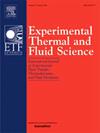Wake asymmetry of a heated cylinder in a cross flow
IF 3.3
2区 工程技术
Q2 ENGINEERING, MECHANICAL
Experimental Thermal and Fluid Science
Pub Date : 2025-07-05
DOI:10.1016/j.expthermflusci.2025.111560
引用次数: 0
Abstract
This paper investigates the flow and temperature distribution around a heated cylinder with an aspect ratio of 3.3 using 2D-PIV and thermocouples in a wind tunnel. The asymmetric wake and the influence of the free-stream turbulence intensity on the flow and temperature field were carefully examined under free-stream cross-flow conditions at a Reynolds number ReD = 2.2 × 104, with the flow being either laminar (Tu = 0.3 %) or turbulent (Tu = 5.9 %) after the artificial transition. Under laminar flow at a Richardson number Ri = 0.01, the heating from the cylinder increases the local air kinematic viscosity by approximately 1.47 times, which in turn, reduces the local Reynolds number to 1.5 × 104. This causes the flow separation to occur earlier compared to the unheated scenario, with the width of the recirculation bubble and the length of vortex formation increasing up 16 % and 13 %, respectively. For heated scenario, geometrically asymmetric wake and surface temperature arise from slight differences in flow separation locations between the upper and lower surfaces, which is driven by local natural convection near the surface. When the free stream is turbulent, the asymmetry wake is weakened, and the surface temperature difference between the upper and lower surfaces decreases by 23 %, which is attributed to the attenuation of the natural convection near the cylinder surface. When comparing the temperature decay after the power to the heated cylinder is turned off, it is evident that temperature decreases more rapidly in the turbulent flow than that in the laminar flow, because of the enhanced forced convection in the turbulent flow.
横流中受热圆柱的尾迹不对称
利用2D-PIV和热电偶在风洞中研究了长径比为3.3的加热圆柱体周围的流动和温度分布。在雷诺数ReD = 2.2 × 104、人工转捩后为层流(Tu = 0.3%)和湍流(Tu = 5.9%)的自由流交叉流条件下,仔细研究了非对称尾迹和自由流湍流强度对流动和温度场的影响。在理查德森数Ri = 0.01的层流条件下,气缸的加热使局部空气的运动粘度增加了约1.47倍,使局部雷诺数降低到1.5 × 104。与未加热的情况相比,这使得流动分离发生得更早,再循环气泡的宽度和漩涡形成的长度分别增加了16%和13%。在加热情况下,尾迹和表面温度的几何不对称是由上下表面流动分离位置的微小差异引起的,这是由表面附近局部自然对流驱动的。自由流湍流时,不对称尾迹减弱,上下表面温差减小23%,这是由于圆柱表面附近自然对流的衰减所致。对比关闭加热筒电源后的温度衰减,可以明显看出湍流中温度下降的速度比层流中要快,这是由于湍流中强制对流的增强。
本文章由计算机程序翻译,如有差异,请以英文原文为准。
求助全文
约1分钟内获得全文
求助全文
来源期刊

Experimental Thermal and Fluid Science
工程技术-工程:机械
CiteScore
6.70
自引率
3.10%
发文量
159
审稿时长
34 days
期刊介绍:
Experimental Thermal and Fluid Science provides a forum for research emphasizing experimental work that enhances fundamental understanding of heat transfer, thermodynamics, and fluid mechanics. In addition to the principal areas of research, the journal covers research results in related fields, including combined heat and mass transfer, flows with phase transition, micro- and nano-scale systems, multiphase flow, combustion, radiative transfer, porous media, cryogenics, turbulence, and novel experimental techniques.
 求助内容:
求助内容: 应助结果提醒方式:
应助结果提醒方式:


